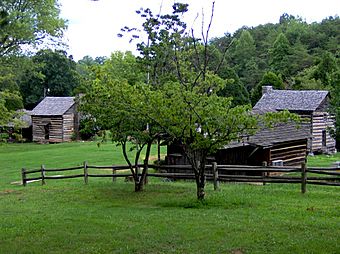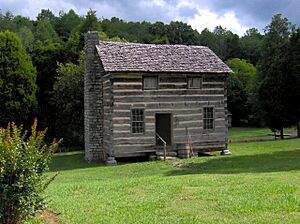Marble Springs facts for kids
Quick facts for kids |
|
|
Marble Springs
|
|
 |
|
| Location | S of Knoxville on Neubert Springs Rd. |
|---|---|
| Nearest city | Knoxville, Tennessee |
| Built | 1790s - early 1800s |
| NRHP reference No. | 71000823 |
| Added to NRHP | May 6, 1971 |
Marble Springs is a special historical place in Knox County, Tennessee. It's also known as the Gov. John Sevier Home. This was the home of John Sevier (1745–1815), who was a hero in the American Revolutionary War. He was also the very first governor of Tennessee! He lived here from 1790 until he passed away in 1815.
For a long time, people thought one cabin here was John Sevier's. But scientists recently found out it was built around the 1830s, after he had already died. They figured this out by studying the tree rings in the logs!
Today, Marble Springs has several old buildings that show what a typical pioneer farm looked like in Sevier's time. Some buildings were moved here from other parts of East Tennessee, and some were rebuilt. The 35.4-acre (0.143 km2) site also has a pavilion and an outdoor stage. It's a great place to learn about early Tennessee history.
Contents
Exploring the Land Around Marble Springs
Marble Springs is located in a valley. To the north, there's a low ridge called Brown Mountain. To the south, there are hills that are part of Bays Mountain. These mountains are part of a bigger area called the Ridge-and-Valley Appalachians. A creek called Stock Creek flows through this area. It eventually empties into Fort Loudoun Lake, which is part of the Tennessee River.
The historic site is easy to find, just off Tennessee State Route 168. This road is also known as Governor John Sevier Highway. Marble Springs is entirely within Knox County.
The Story of John Sevier and Marble Springs
John Sevier moved to Tennessee from Virginia in the early 1770s. He quickly became known as a brave leader of frontier soldiers. He helped the American side win the Battle of King's Mountain in 1780. He also defeated the Cherokee people at the Battle of Boyd's Creek that same year.
Sevier was the only governor of a short-lived state called the State of Franklin from 1785 to 1788. Later, he became the first governor of Tennessee. He served six terms, from 1796 to 1801 and again from 1803 to 1809. He also served as a state senator and a U.S. congressman until he passed away.
Sevier officially owned the Marble Springs land in 1796. However, he was living there as early as 1790. The site was close enough to Knoxville, which was the capital of the Southwest Territory at the time. He named his home "Marble Springs" because of the springs on the property that flowed all year long. His farm had many buildings, including a springhouse, a corn crib, a smokehouse, and several other cabins.
After John Sevier died, his children sold Marble Springs in 1818. Later, a family named Kirby lived there. In 1941, the state of Tennessee bought the property to save and restore it. Today, the Tennessee Historical Commission helps manage this important historical site.
What Tree Rings Tell Us About the Cabins
In 2007, experts from the University of Tennessee studied the logs in the Sevier cabin and the Walker cabin. They used a method called dendrochronology, which means studying tree rings. By looking at the rings, they could tell when the trees were cut down.
They found that the oldest logs in the "Sevier" cabin were cut around 1835. This means the cabin was built well after John Sevier had died. It was likely built by George Kirby, who lived at Marble Springs as a tenant during that time.
Historic Buildings at Marble Springs
Besides the "Sevier" cabin, several other buildings have been added to Marble Springs. They help visitors imagine what life was like on an 18th-century farm in the Tennessee Valley. In John Sevier's time, a large farm like his would have had many barns, smokehouses, and other buildings spread across its 375-acre (1.52 km2) land.
- The John Sevier Cabin: This cabin was built around 1835. It is the only building that was originally on this exact spot. It has a "dog-trot" kitchen, which was a common design for pioneer cabins. Inside, you can see items donated by the Sevier family.
- The Walker Cabin: This building was moved here from another farm in Knox County. It was built around 1828. At Marble Springs, the Walker cabin helps show what a frontier tavern might have looked like. Scientists confirmed its building date by studying its logs in 2007.
- The McCall Smokehouse: This smokehouse was built around 1850. It was donated by the McCall family, who lived a few miles south of Marble Springs.
- The Loom House: This building was constructed in 1970. It was made using logs from an old building on the McCall farm. Inside, you can see looms and spinning wheels used to make cloth from wool and flax.
Other buildings you can see include a springhouse, where fresh water was kept cool, a corn crib for storing corn, and various work areas.
See also



